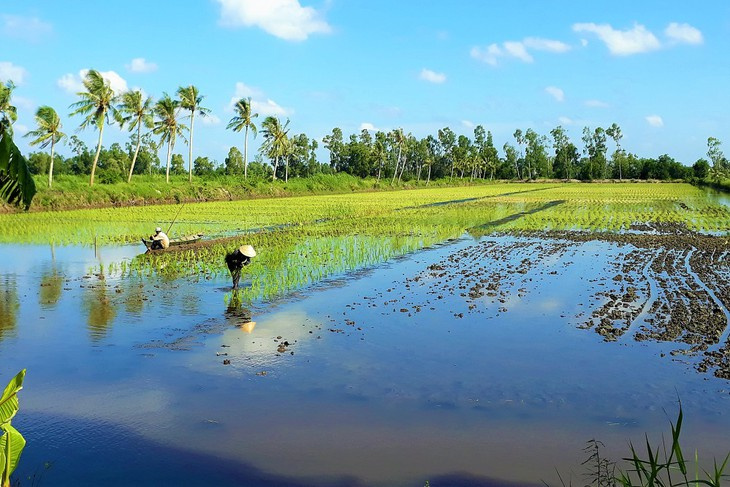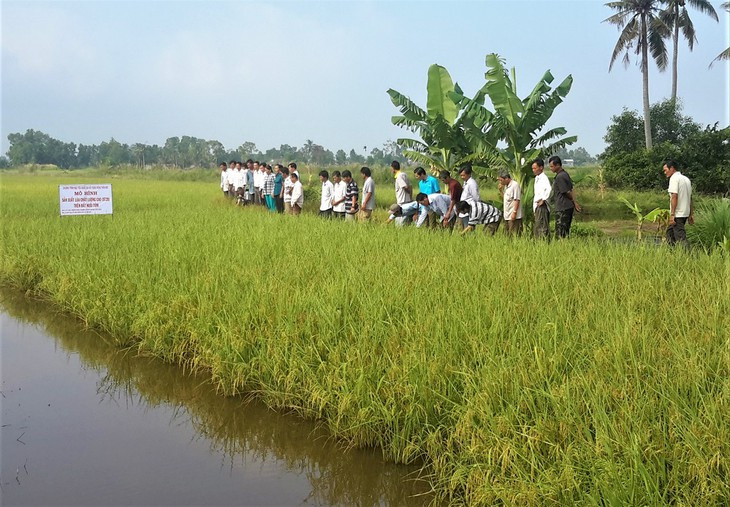Quang Binh farmers enjoy bumper rice crop
NDO – Local farmers in the central province of Quang Binh have harvested about 50% of the winter-spring rice
Tran Van Thiet in Tri Luc commune combines shrimp farming with one rice crop on 1.5 ha of what is known as rice-shrimp land.
In the past, whenever the rainy season came, Thiet grew one ha of rice. After many years the land had become heavily salinized, making it hard to grow rice or shrimp.
To find a new development direction, in 2018, Thiet joined the Tri Luc Rice-Shrimp Production Cooperative. Cooperative members must abide by an organic rice cultivation process for exports, ensuring the strictest standards from soil improvement to pest management. They are not allowed to use any chemical fertilizers and have switched to high yield rice varieties like ST24.
Kiet said that after two years, his family’s yield is 10% higher with each rice crop. And the rice quality meets the standards for export to any market. All of his rice is sold at a price 0.03 USD per kilo higher than the market price.
“My family has one ha of rice cultivation land. Since we started growing organic ST24 rice, our profits have increased about 20%,” said Kiet.
Tri Luc Rice-Shrimp Production Cooperative began in 2018 with just 15 members and about 50 hectares of cultivated land.
In their first crop of organic rice, only half the land produced qualified rice. But other people saw the model’s effectiveness and began to follow suit.
One year later, the cooperative had 117 hectares of certified organic rice and 700 hectares of certified safe rice. This year 540 households have registered to use the organic rice process, hoping to produce 200 ha of certified organic rice for export to the US, the EU, and Japan.
Le Van Mua, the Cooperative’s Director, said the model improves rice productivity and quality and creates a clean environment for shrimp farming.
He said, “To grow organic rice, you need to follow a strict process. At first farmers might be reluctant, but they soon understand that growing organic rice results in higher profits and a cleaner environment. What they need to remember is not to overuse chemical fertilizers.”
Tri Luc Rice-Shrimp Production Cooperative is one of several cooperatives in Thoi Binh district that have mobilized farmers to expand the organic rice growing area.
A trademark for safe rice in Thoi Binh district was recognized in 2019. In 2020, 800 of the 20,000 rice-shrimp ha in Thoi Binh followed the organic process.
The district hopes to have 5,000 of its 21,000 ha of safe rice certified as organic rice by 2025 and is building a safe rice material zone linked to eco-tourism.
Nguyen Hoang Lam, head of Thoi Binh district’s Agriculture and Rural Development section, said, “To maintain the brand, we’ve passed a resolution promoting organic rice linked to community-based eco-tourism.”
Lam added, “We continue to urge businesses to sign contracts to buy all the rice produced. Cooperatives should ensure both input and output for production chains. Thoi Binh is now setting up eco-tourism villages.”
Ca Mau has 40,000 ha of rice-shrimp areas, mostly in Thoi Binh district. Under the safe rice model, local farmers are raising tiger prawns, crayfish, and crabs, which will soon follow the organic model.

